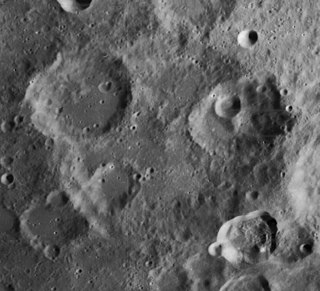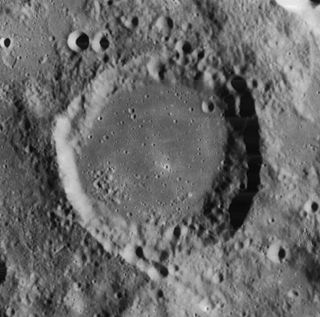
Zach is a lunar impact crater located in the heavily cratered southern sector of the Moon. To the north is the crater Lilius, while to the southeast is Pentland and to the south the larger Curtius. Due to foreshortening, the crater has an oblong appearance when viewed from Earth. The crater is 71 kilometers in diameter and 3.7 kilometers deep. It is from the Nectarian period, 3.92 to 3.85 billion years ago.

Abul Wafa is an impact crater located near the lunar equator on the far side of the Moon, named after the Persian mathematician and astronomer Abu al-Wafa' Buzjani. To the east are the crater pair Ctesibius and Heron. In the northeast lies the larger crater King, and to the southwest is Vesalius.

Hommel is a lunar impact crater located in the southeast section of the Moon, in a region that is deeply impacted with a multitude of impact craters. The most notable craters nearby are Pitiscus to the north; Rosenberger due east; and Nearch to the southeast. The prominent crater Vlacq is nearly attached to the northeast rim. Also nearby is Asclepi to the west. Hommel is about 120 kilometers in diameter and its walls reach heights of 2,800 meters. It is from the Pre-Nectarian period, 4.55 to 3.92 billion years ago.

Abulfeda is a lunar impact crater located in the central highlands of the Moon. To the northeast is the crater Descartes, and to the south-southeast is Almanon. To the north is the crater Dollond. A chain of craters named the Catena Abulfeda runs between the southern rim of Abulfeda and the north rim of Almanon, then continues for a length of 210 kilometers across the Rupes Altai. The crater was named for 14th century Syrian-born Kurdish historian Ismael Abul-fida.

Capella is a lunar impact crater 49 km (30 mi) in diameter that lies to the north of the Mare Nectaris, in a rugged region with many small impact craters. It was named after Roman astronomer Martianus Capella. It intrudes slightly into the eastern rim of the crater Isidorus, a feature only slightly smaller in diameter.

Delambre is a lunar impact crater that lies to the southwest of Mare Tranquillitatis, in the central highland region. To the west is the crater pair of Theon Junior and Theon Senior, the latter being more distant and located to the northwest.

Apianus is a lunar impact crater that is located on the rugged south-central highlands of the Moon. It is named after 16th century German mathematician and astronomer Petrus Apianus. It is located to the northeast of the crater Aliacensis, and to the northwest of Poisson. The worn crater Krusenstern is attached to the west-northwestern rim.

Donati is a lunar impact crater that is located in the rugged south-central highlands of the Moon. It lies just to the northwest of the crater Faye, and the two outer rims are separated by a gap of less than 10 kilometers. To the north is the comparably sized Airy, and farther to the southeast is Playfair. Donati is 36 kilometers in diameter.

Fizeau is a prominent lunar impact crater that is located on the far side of the Moon, in the southern hemisphere. Nearby craters of note include Minkowski to the west-northwest, and Eijkman to the southwest.
Mutus is a lunar impact crater that is located in the rugged southern part of the Moon. It lies to the north-northeast of the larger crater Manzinus, and some distance to the south of Hommel. It is 78 kilometers in diameter and 3.7 kilometers deep. It is from the Pre-Nectarian period, 4.55 to 3.92 billion years ago.

Nicolai is a lunar impact crater that is located in the southern hemisphere of the Moon, in a region that is less disturbed by significant impacts than most of the highlands. The nearest craters of note are Spallanzani to the south, and the much larger Maurolycus and Barocius to the east. The crater is named after the 19th-century German astronomer Friedrich Bernhard Gottfried Nicolai. It is 42 kilometers in diameter and reaches a depth of 1.8 kilometers.

Deluc is a lunar impact crater that lies in the southern highlands of the Moon. It is located to the south-southeast of the crater Maginus, and the huge Clavius. Due east of Deluc is the somewhat larger crater Lilius. It is 47 kilometers in diameter and 3.3 kilometers deep. It is from the Pre-Imbrian period, which lasted from 4.55 to 3.85 billion years ago.

Curtius is a lunar impact crater that is located in the southern part of the Moon. From the Earth the crater appears foreshortened, making it more difficult to observe detail. Nevertheless, this is a large crater that can be readily found in even small telescopes. Curtius is located within one crater diameter of the still-larger Moretus to the southwest. To the northeast is the smaller Pentland. Curtius is 95 kilometers in diameter and 6.8 kilometers deep. It is from the Nectarian period, 3.92 to 3.85 billion years ago.

Steinheil is a lunar impact crater that is located in the rugged highlands in the southeastern part of the Moon. It was named after German astronomer and physicist Carl August von Steinheil. It forms a prominent crater pair with the similar-sized Watt, which it partly overlies to the southeast. To the northwest is the large walled plain Janssen. Due to the location of this crater, it appears foreshortened when viewed from the Earth. It is from the Nectarian period, 3.92 to 3.85 billion years ago.

Licetus is a lunar impact crater on the near side of the Moon, in the rugged southern highland region. It lies to the south of the walled plain Stöfler, and is attached to the northern rim of the sub-divided crater Heraclitus. Just to the southeast is Cuvier. Licetus is 75 kilometers in diameter and 3.8 kilometers deep. It is from the Pre-Nectarian period, 4.55 to 3.92 billion years ago.

Dyson is a lunar impact crater, 63 kilometers in diameter, that lies on the far side of the Moon, past the northwest limb. It is located in the northern part of the surface, to the northwest of the crater Coulomb, and east of van't Hoff.

Heinsius is an eroded lunar impact crater that lies in the southwestern part of the Moon. It is named after German astronomer Gottfried Heinsius. It is located to the northwest of the prominent crater Tycho, and rays from that formation pass to the north and south of Heinsius as well as marking the rim and interior with material. To the south-southwest of Heinsius is the larger walled plain Wilhelm.

Faye is a heavily eroded lunar impact crater in the rugged southern highlands of the Moon. It is named after French astronomer Hervé Faye. It is attached to the northeastern rim of the crater Delaunay, with Donati located just a few kilometers to the northeast. It forms part of a chain of craters of increasing size to the southwest that continues with La Caille and ends with the walled plain Purbach.

Peirescius is a lunar impact crater that is located in the southeastern part of the Moon. It is close enough to the limb that it appears significantly foreshortened when viewed from the Earth, even though it is nearly circular in shape. To the west-northwest of Peirescius is the crater Vega, and less than one crater diameter to the south is Brisbane. Farther to the east is the Mare Australe.

Rosenberger is an old lunar impact crater in the southeastern part of the Moon. It was named after German astronomer Otto August Rosenberger.
























